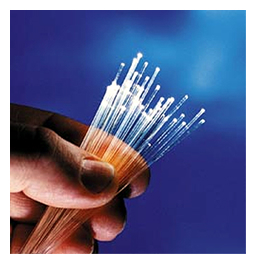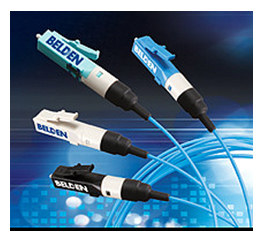Copper and Fiber Vie for Position
 Copper and Fiber Vie for Position
Copper and Fiber Vie for Position
For nearly 40 years, fiber optic communication technology has experienced a unique combination of success and failure. Fiber optic cables offered the ability to send thousands of voice channels many kilometers without amplification, and they were quickly adopted by the telecommunications industry for long-haul applications. These tiny glass strands replaced bundles of copper wire that were prone to crosstalk, signal loss, and corrosion.
As the Internet expanded, devotees of fiber saw it as the ultimate communication media, and predicted immense growth of fiber optics in all types of equipment. Huge investments in the development of fiber, connectors, filters, splitters, and transceivers were made in expectation of the eminent demise of copper.
But these grandiose forecasts proved wildly optimistic as engineers continued to find ways to extend the useful bandwidth of conventional copper conductors in both I/O and PCB applications. Low voltage differential signaling reduced distortion due to external EMI. Improved dielectrics and signal/ground pin assignment patterns improved crosstalk characteristics in connectors. Major advances in chip technology introduced signal conditioning features, including pre-emphasis and equalization that enabled circuits to distinguish and reconstruct data signals buried in noise and distortion. The science of signal integrity developed guidelines for successful design of multi-gigabit circuits. Designers found that copper remained the most cost-effective choice while minimizing risks associated with the introduction of any new technology.
Vast improvements in copper signal transmission, together with the lingering effects of multiple economic recessions, caused many promising optical research projects to be shelved. Fiber continued to offer almost unlimited bandwidth to next-generation equipment in a future that continued to be pushed out. When asked to estimate when fiber optics will achieve economic parity with copper, engineers came up with a range that stretched from two years to never. On one recent survey, very few respondents were even willing to offer a guess.
Today, copper conductors remain the primary media in the vast majority of consumer, commercial, and military circuits. Copper is widely expected to remain the dominant technology for many years, but evolutionary advances in technology and component production costs are influencing the balance between copper and fiber. It may be time to look at fiber again for the future. The laws of physics may ultimately impose limitations on copper that, over time, will tip the advantage to fiber.
As data rates increase into the gigabit range, high-speed signals tend to propagate on the surface of a copper conductor. The much-reduced area available for signal conduction results in greater attenuation. One solution to this problem is to increase the gauge of the conductor to provide more surface area. This can reduce the attenuation problem, but adds to cable bulk and weight, both undesirable characteristics in high-density I/O panels and cable trays that are filled to capacity. Electronic systems in commercial and military aircraft must fit whatever cramped spaces are available. Large square card cages may be broken into multiple subsystems located throughout the aircraft and cabled together. Minimizing weight and bulk are critical issues for high-speed cables used to link these remote boxes.
Another issue is crosstalk. As signal speeds increase, crosstalk between parallel conductors goes up. Crosstalk distorts the signal and eventually makes it difficult or impossible to detect at the receiver.
Designers can:
- Increase the distance between conductors, reducing signal density
- Add shielding structures, consuming more space and adding cost and weight
- Add active signal-conditioning features on the PCB or to the cable assembly. But these increase cost, consume power, and potentially cause interoperability issues between multiple vendors
A third issue is related to the practical length of a cable assembly, also known as reach. As signal speeds increase, the effective length of a copper cable becomes shorter. The combined effects of attenuation and crosstalk increase with length, effectively capping the reach of copper high-speed cables.
Additional issues associated with high-speed copper conductors include susceptibility to external EMI, signal skew, latency, inter-symbol interference, security, voltage isolation, and equipment damage resulting from conducted electrostatic discharge. Continuing increases in the cost of copper on the world commodity market has also been cause for concern.
Fiber optic links are not perfect, but they offer almost unlimited bandwidth, can propagate high-speed signals many miles without amplification, are immune to EMI and ESD, weigh a fraction of what copper cables do with increased bandwidth, and are nearly impossible to tap, making fiber ideal where security is a concern.
One of the factors that has delayed wide adoption of fiber has been the added cost of components that convert electrical signals to optic at the transmit end, and optic signals back to electrical at the receiver. The added cost of electro-optic conversion, as well as reluctance to espouse a new media, has slowed consideration of fiber. Introducing a new manufacturing process to replace known and thoroughly documented copper conductors can result in understandable reluctance to adopt a new technology. Reliable solder joints have existed since the introduction of electronics, and crimp technology has been proven for more than 70 years, since its introduction. Relatively untrained personnel can quickly create highly reliable connections using simple tools readily available in the field. The laborious, time consuming, and challenging termination process required by some fiber optic connectors contributed to this concern.
Two major economic recessions over the past 10 years also tended to discourage designing a new product dependent on new technology. One engineer commented that fiber would become the preferred media when copper cannot provide the required bandwidth and fiber becomes the only cost-effective alternative.
 Optical fiber and connector manufacturers have been busy addressing user concerns about fiber. Terminating a fiber optic connector has been one of the largest objections in applications that require field termination. Standard fiber connectors often required special stripping and polishing tools and the use of disposables, including polishing fixtures, lapping paper, and epoxy. Specialized inspection scopes determine if the termination process was successful, or not. More importantly, successful termination required highly trained personnel with practiced expertise to produce consistently good terminations.
Optical fiber and connector manufacturers have been busy addressing user concerns about fiber. Terminating a fiber optic connector has been one of the largest objections in applications that require field termination. Standard fiber connectors often required special stripping and polishing tools and the use of disposables, including polishing fixtures, lapping paper, and epoxy. Specialized inspection scopes determine if the termination process was successful, or not. More importantly, successful termination required highly trained personnel with practiced expertise to produce consistently good terminations.
The introduction of newer connectors that feature crimp or self-actuated mechanical attachment eliminates the requirement for adhesives. Connectors that feature pre-polished mating faces has made field termination of fiber connectors faster and much more reliable.
- Digital Lighting Enhances your Theatrical Experience - March 5, 2024
- DesignCon 2024 in Review - February 13, 2024
- Chip Technology Struggles to Keep Pace with Moore’s Law - January 30, 2024

